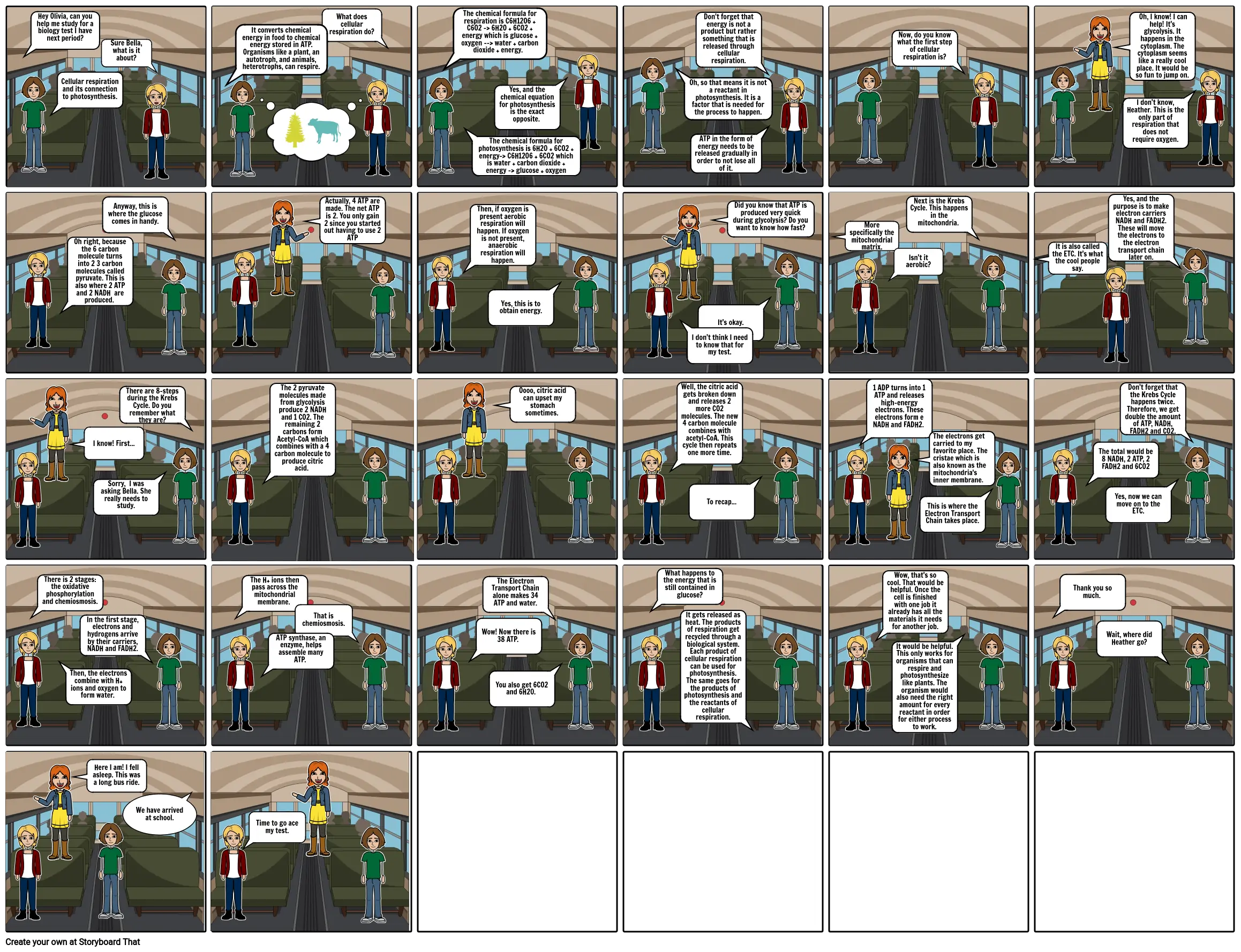Respiration Comic

Storyboard Tekst
- Hey Olivia, can you help me study for a biology test I have next period?
- Cellular respiration and its connection to photosynthesis.
- Sure Bella, what is it about?
- It converts chemical energy in food to chemical energy stored in ATP. Organisms like a plant, an autotroph, and animals, heterotrophs, can respire.
- What does cellular respiration do?
- The chemical formula for respiration is C6H12O6 + C6O2 -> 6H2O + 6CO2 + energy which is glucose + oxygen --> water + carbon dioxide + energy.
- The chemical formula for photosynthesis is 6H20 + 6CO2 + energy-> C6H12O6 + 6CO2 which is water + carbon dioxide + energy -> glucose + oxygen
- Yes, and the chemical equation for photosynthesis is the exact opposite.
- Oh, so that means it is not a reactant in photosynthesis. It is a factor that is needed for the process to happen.
- ATP in the form of energy needs to be released gradually in order to not lose all of it.
- Don't forget that energy is not a product but rather something that is released through cellular respiration.
- Now, do you know what the first step of cellular respiration is?
- Oh, I know! I can help! It's glycolysis. It happens in the cytoplasm. The cytoplasm seems like a really cool place. It would be so fun to jump on.
- I don't know, Heather. This is the only part of respiration that does not require oxygen.
- Oh right, because the 6 carbon molecule turns into 2 3 carbon molecules called pyruvate. This is also where 2 ATP and 2 NADH are produced.
- Anyway, this is where the glucose comes in handy.
- Actually, 4 ATP are made. The net ATP is 2. You only gain 2 since you started out having to use 2 ATP
- Then, if oxygen is present aerobic respiration will happen. If oxygen is not present, anaerobic respiration will happen.
- Yes, this is to obtain energy.
- I don't think I need to know that for my test.
- It's okay.
- Did you know that ATP is produced very quick during glycolysis? Do you want to know how fast?
- More specifically the mitochondrial matrix.
- Isn't it aerobic?
- Next is the Krebs Cycle. This happens in the mitochondria.
- It is also called the ETC. It's what the cool people say.
- Yes, and the purpose is to make electron carriers NADH and FADH2. These will move the electrons to the electron transport chain later on.
- I know! First...
- Sorry, I was asking Bella. She really needs to study.
- There are 8-steps during the Krebs Cycle. Do you remember what they are?
- The 2 pyruvate molecules made from glycolysis produce 2 NADH and 1 CO2. The remaining 2 carbons form Acetyl-CoA which combines with a 4 carbon molecule to produce citric acid.
- Oooo, citric acid can upset my stomach sometimes.
- Well, the citric acid gets broken down and releases 2 more CO2 molecules. The new 4 carbon molecule combines with acetyl-CoA. This cycle then repeats one more time.
- To recap...
- 1 ADP turns into 1 ATP and releases high-energy electrons. These electrons form e NADH and FADH2.
- The electrons get carried to my favorite place. The cristae which is also known as the mitochondria's inner membrane.
- This is where the Electron Transport Chain takes place.
- The total would be 8 NADH, 2 ATP, 2 FADH2 and 6CO2
- Yes, now we can move on to the ETC.
- Don't forget that the Krebs Cycle happens twice. Therefore, we get double the amount of ATP, NADH, FADH2 and CO2.
- There is 2 stages: the oxidative phosphorylation and chemiosmosis.
- Then, the electrons combine with H+ ions and oxygen to form water.
- In the first stage, electrons and hydrogens arrive by their carriers, NADH and FADH2.
- The H+ ions then pass across the mitochondrial membrane.
- ATP synthase, an enzyme, helps assemble many ATP.
- That is chemiosmosis.
- Wow! Now there is 38 ATP.
- The Electron Transport Chain alone makes 34 ATP and water.
- You also get 6CO2 and 6H20.
- What happens to the energy that is still contained in glucose?
- It gets released as heat. The products of respiration get recycled through a biological system. Each product of cellular respiration can be used for photosynthesis. The same goes for the products of photosynthesis and the reactants of cellular respiration.
- Wow, that's so cool. That would be helpful. Once the cell is finished with one job it already has all the materials it needs for another job.
- It would be helpful. This only works for organisms that can respire and photosynthesize like plants. The organism would also need the right amount for every reactant in order for either process to work.
- Thank you so much.
- Wait, where did Heather go?
- Here I am! I fell asleep. This was a long bus ride.
- We have arrived at school.
- Time to go ace my test.
Meer dan 30 miljoen storyboards gemaakt

